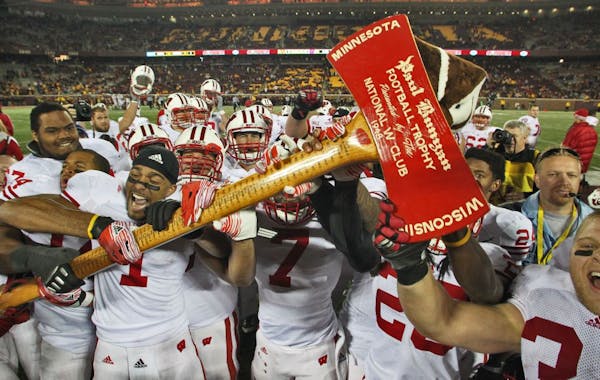The first two times the Gophers played Wisconsin under football coach Jerry Kill, the results weren't pretty for Minnesota. The Gophers lost 42-13 two years ago and 38-13 last year, making the average margin of defeat 27 points.
The Gophers hope this Saturday's battle for Paul Bunyan's Axe at TCF Bank Stadium will be a much different story. Both teams are 8-2. Wisconsin appears to have a better team than the one that finished 8-6 last year, but Minnesota has made even bigger strides after last year's 6-7 finish.
For the Gophers, two statistics stand out: They are scoring 30.7 points per game, an increase from 22.1 last year. Then there's the turnover margin. The Gophers were minus-two last year (20 turnovers caused, 22 committed), and this year they are plus-six (15 caused, nine committed).
Minnesota has transformed itself from a team that felt fortunate to reach a bowl game last year to one with an outside chance at reaching the Big Ten title game. Here are the five main reasons for the turnaround:
1. David Cobb's emergence
Kill and offensive coordinator Matt Limegrover have built a ball-control offense that can control the clock. The Gophers ranked fourth in the Big Ten last year with an average time of possession of 31 mnutes, 3 seconds this year, they've climbed to third at 33:23.
To do this, it takes a strong offensive line and good running back play.
Donnell Kirkwood led the Gophers last year with 71.2 rushing yards per game. In the process, he averaged 4.2 yards per carry. He sprained his ankle in this year's opener, and David Cobb has emerged as the team's go-to running back.
Cobb ranks fifth in the Big Ten, averaging 94.2 yards per game. He averages 5.4 yards per carry and has rushed for at least 138 yards in the past three games.
2. Philip Nelson's efficiency
Another key to the improved offense has been the quarterback play. Philip Nelson made seven starts as a freshman last year and turned in a passer efficiency rating of 104.4.
This statistic is a combined measure of completion percentage, passing yardage, touchdowns and interceptions. Nelson's overall passer efficiency rating this year is 141.6; in Big Ten play it's 159.4, which ranks second to Ohio State's Braxton Miller (165.7).
When Nelson was slowed because of a hamstring injury, Mitch Leidner gave the Gophers a potent running threat at quarterback and a 124.6 passer efficiency.
But Nelson has returned and found another level. He hasn't fumbled or thrown an interception since the Sept. 28 loss to Iowa. Since then, he has passed for seven touchdowns and run for three.
3. The Maxx Williams effect
The most glaring concern for the Gophers early this season was their wide receivers. A.J. Barker quit the team last season, leaving no one else who had caught more than 20 passes.
Derrick Engel has helped fill that void, with 25 catches for 401 yards and five touchdowns. Donovahn Jones and Drew Wolitarsky, both true freshmen, have been coming on strong of late, giving Nelson other open wide receiver targets.
But one of the team's best weapons has been true freshman tight end Maxx Williams, who has 17 receptions for 299 yards and four touchdowns.
The Gophers got seven touchdown receptions from their tight ends last year — four by John Rabe and three by Drew Goodger — so this isn't an entirely new wrinkle. But Williams has emerged as one of the best players on the team, with a knack for making big plays on third and fourth down.
4. Special teams improvements
Kill says he wants his team to win two of three phases each game between offense, defense and special teams. Aside from the Indiana game, which included some long kickoff returns by the Hoosiers, the Gophers have held a special teams edge in each contest.
The year started with two electrifying touchdown returns from Marcus Jones — one on a kickoff, one on a punt. An ankle injury has slowed him down, but the Gophers still are finding an edge with their kicking and punting.
Jordan Wettstein hit 14 of 22 field goals for the Gophers last year. This year, senior Chris Hawthorne is 12-for-15.
Last year, the Gophers ranked last in the Big Ten with a net punting average of 34.2 yards. Sophomore Peter Mortell took over the punting duties for Christian Eldred this year, and the Gophers rank fourth in the Big Ten in net punting average at 38.1 yards.
Mortell won Big Ten Special teams player of the week honors in each of the Gophers' past two games.
5. An opportunistic defense
When the Gophers improved from 3-9 to 6-7 in Kill's first two years, they owed much of that improvement to their defense, which allowed 24.7 points per game last year, down from 31.7 in 2011.
This year, the Gophers have lowered that number to 23.4 points per game, despite giving up more yards (380.8 per game) than last year (358.6). Defensive coordinator Tracy Claeys preaches the importance of "defending every inch," and the Gophers have been opportunistic.
Linebacker James Manuel had a critical 24-yard interception return for a touchdown in the 20-17 victory at Northwestern. The Gophers escaped Indiana with a 42-39 victory after linebacker Aaron Hill picked up a fumble on a lateral in the waning seconds.
Most recently, Penn State went scoreless in the second half of its 24-10 loss at Minnesota, but that included a fumbled snap at the 1-yard line by Nittany Lions quarterback Christian Hackenberg.
"If you play hard," Kill said, "sometimes things fall your way."

Going to Wolves or Twins tonight? How to get there (and maybe avoid traffic).
Ex-Gophers forward Payne transferring to Texas A&M
Focusing on bringing football film into frame
Analysis: Golf has two dominant forces in Scheffler and Korda. It didn't happen overnight

